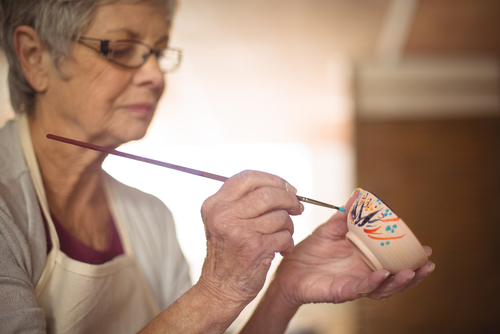Abbreviations Used in Physical Therapy
Category:

Physical therapists will often use abbreviations and terms, which may be confusing to the average person. One may wonder: What is weight-bearing status? What does non-weight-bearing really mean? And what about the corresponding abbreviations such as the WBAT medical abbreviation, the NWB medical abbreviation, or the NWB LLE medical abbreviation? What about the medical abbreviation for LLE or the RLE medical abbreviation?
We’ll go through the alphabet soup of physical therapy medical abbreviations in this post.
Weight Bearing Abbreviations
The idea of “weight-bearing” in physical therapy includes several abbreviations. However, we must first review the meaning behind weight bearing before diving into the corresponding acronyms.
Download Our Senior Exercising Guide
What Does Weight Bearing Mean?
Weight-bearing, which is the WB physical therapy abbreviation, refers to the amount of weight one puts on an injured body part. It usually refers to a foot, leg, or ankle that has been fractured or has been performed surgery on but it can also refer to resting on a wrist or arm.
Weight Bearing Status Grades
The surgeon or treating physician will prescribe an appropriate weight-bearing status grade depending on the patient’s ability level. These abbreviations include:
-
WBAT: Weight-bearing status as tolerated (additionally, the “as tolerated” medical abbreviation on its own can be used “as tol”), meaning one may place as much weight through the leg as tolerated, to their comfort.
-
FWB: Full weight-bearing, meaning there are no restrictions to weight-bearing.
-
NWB: Non-Weight Bearing, meaning one should not put any weight on the affected limbs.
-
NWB LLE: Non-weight-bearing left lower extremity, meaning one should not put any weight on the left area of the body from the hips to the toes.
-
NWB RLE: Non-weight bearing right lower extremity, meaning one should not put any weight on the right area of the body from the hips to the toes.
-
TTWB: Toe touch weight-bearing, meaning the ability to touch the foot or toes to the floor without the affected limb providing support.
-
PWB: Partial weight-bearing, a broad term ranging from anything more than non-weight bearing to less than full weight-bearing.
Other Abbreviations Used in Physical Therapy
Below, you will find several other common abbreviations used in physical therapy.
-
#: Pounds
-
4WW: Four-wheeled walker
-
a (with a line over it): Before
-
AAROM: Active assistive range of motion
-
ABD: Abduction
-
AC: Acromioclavicular
-
ACDF: Anterior cervical discectomy and fusion
-
ACJ: Acromioclavicular joint
-
ACL: Anterior cruciate ligament
-
AD: Assistive device
-
ADD: Adduction
-
ADL: Activity/activities of daily living
-
AFO: Ankle foot orthosis, (used to treat foot drop)
-
AICD: Automated implantable cardiac defibrillator
-
AKA: Above-knee amputation
-
Amb: Ambulation
-
A/P: Anterior/posterior
-
AROM: Active range of motion
-
B: Bilateral
-
BID: Twice a day
-
BKA: Below-knee amputation
-
c (with a line over it): With
-
CABG: Coronary artery bypass graft (open heart surgery)
-
CGA: Contact guard assist
-
CKC: Closed kinetic chain
-
C/O: Complains of
-
CP: Cold pack, cerebral palsy
-
CPM: Continuous passive motion
-
CTx: Cervical traction
-
DB: Dumbbell
-
DDD: Degenerative disc disease
-
DF: Dorsiflexion
-
DJD: Degenerative joint disease
-
EOB: Edge of bed
-
ER: External rotation
-
Estim or ES: Electrical stimulation
-
EV: Eversion
-
Ex: Exercise
-
Ex Lap: Exploratory laparotomy or laparoscopy
-
Ext (or /): Extension
-
FIM score: Functional independence level
-
Flex (or ✓): Flexion
-
FWW: Front-wheeled walker
-
Fx: Fracture
-
GHJ: Glenohumeral joint
-
HEP: Home exercise program
-
HKAFO: Hip-knee-ankle foot orthosis
-
HNP: Herniated nucleus pulposus (herniated disc)
-
H/o: History of
-
HOB: Head of bed
-
Horiz: Horizontal
-
Horiz ABD: Horizontal abduction
-
Horiz ADD: Horizontal adduction
-
HP: Hot pack
-
HVGS: High-voltage galvanic stimulation
-
Hx: History
-
I (or Ind): Independent
-
I&D: Incision and drainage
-
IV or (or Inv): Inversion
-
Ionto: Iontophoresis
-
IR: Internal rotation
-
ITB: Iliotibial band
-
KAFO: Knee ankle foot orthosis
-
L: Left
-
LAQ: Long-arc quad
-
LBQC: Large-base quad cane
-
LCL: Lateral collateral ligament
-
LE: Lower extremity
-
LLE: Left lower extremity
-
RLE: Right lower extremity
-
LOA: Level of assist
-
LOS: Length of stay
-
LP: Leg press or lumbar puncture acutely
-
LSO: Lumbosacral orthosis
-
LTG: Long-term goals
-
Max A: Maximum assist
-
MCL: Medial collateral ligament
-
MD: Medical doctor
-
MFR: Myofascial release
-
MHP: Moist hot pack
-
Min A: Minimum assist
-
Mm: Muscle
-
MMT: Manual muscle test
-
Mob: Mobilization
-
Mod I: Modified independent
-
NBQC: Narrow base quad cane
-
NDT: Neuro-developmental technique (also known as Bobath technique)
-
NMES: Neuromuscular electrical stimulation
-
NWB: Non-weight bearing
-
OKC: Open kinetic chain
-
OOB: Out of bed
-
PCL: Posterior cruciate ligament
-
PD: Peritoneal dialysis
-
PEG: Percutaneous endoscopic gastrotomy
-
PF: Plantarflexion
-
Pfin: Paraffin bath
-
PFS: Patellofemoral syndrome
-
Phono: Phonophoresis
-
PICC: Peripherally inserted central catheter
-
PLIF: Posterior lumbar interbody fusion
-
PMHx: Past medical history
-
PNF: Proprioceptive neuromuscular facilitation
-
Pro: Pronation
-
PROM: Passive range of motion
-
PT: Physical therapy
-
Pt: Patient
-
PTA: Physical therapy assistant
-
PUW: Pick-up walker
-
Q: Every
-
QC: Quad cane
-
QD: Every day
-
QID: Four times a day
-
R: Right
-
RC: Rotator cuff
-
RD: Radial deviation
-
RICE: Rest, ice, compression, elevation
-
ROM: Range of motion
-
Rot: Rotation
-
RT: Respiratory therapist, or respiratory therapy
-
RW: Rolling walker
-
s (with a line over it): Without
-
SAQ: Short arc quad
-
SB: Side bending (or Swiss ball)
-
SBA: Stand-by assist
-
SBQC: Small base quad cane (also known as a narrow base quad cane—NBQC)
-
SC: Straight cane
-
SLR: Straight leg raise
-
SPC: Single-point cane
-
STM: Soft tissue mobilization
-
STS: Sit-to-stand
-
Sup: Supination
-
SW: Standard walker
-
TB: TheraBand
-
TDWB: Touch-down weight bearing
-
TENS: Transcutaneous electrical neuromuscular stimulation
-
THA: Total hip arthroplasty
-
Ther Ex: Therapeutic exercise
-
THR: Total hip replacement
-
TID: Three times a day
-
TKA: Total knee arthroplasty
-
TKR: Total knee replacement
-
TLSO: Thoracic lumbar-sacral orthosis
-
TLIF: Transforaminal lumbar interbody fusion
-
TM: Treadmill
-
TMJ: Temporomandibular joint
-
Total A: Total assist
-
Trxn: Traction
-
UBE: Upper body ergometer
-
UD: Ulnar deviation
-
UE: Upper extremity
-
US: Ultrasound
-
WBQC: Wide-base quad cane
-
WC (or w/c): Wheelchair
-
WFL: Within functional limits
-
WNL: Within normal limits
-
WW: Wheeled walker
Subscribe
Date: March 24, 2022
Category:


